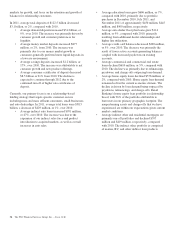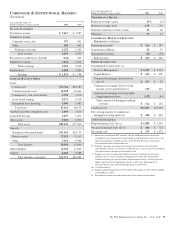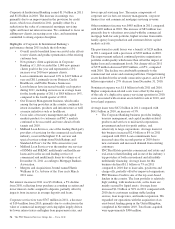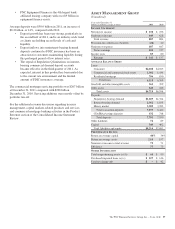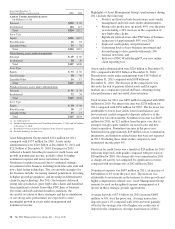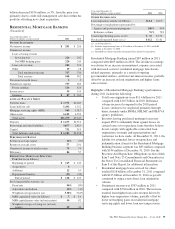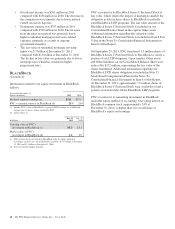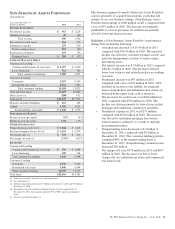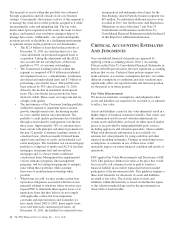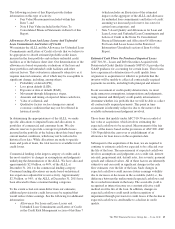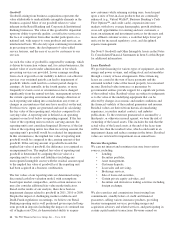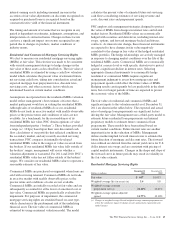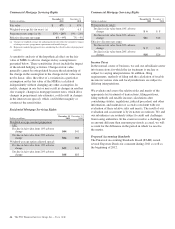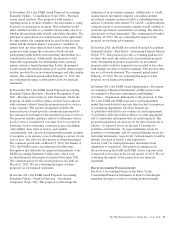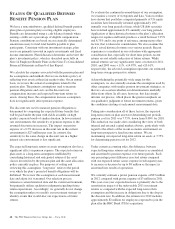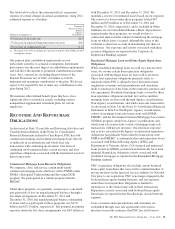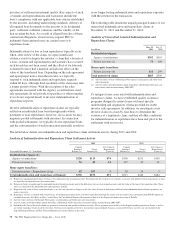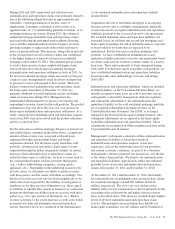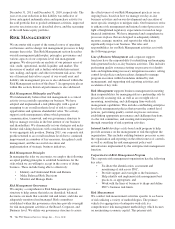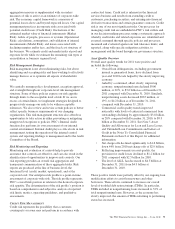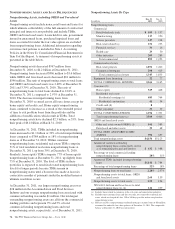PNC Bank 2011 Annual Report Download - page 73
Download and view the complete annual report
Please find page 73 of the 2011 PNC Bank annual report below. You can navigate through the pages in the report by either clicking on the pages listed below, or by using the keyword search tool below to find specific information within the annual report.Goodwill
Goodwill arising from business acquisitions represents the
value attributable to unidentifiable intangible elements in the
business acquired. Most of our goodwill relates to value
inherent in the Retail Banking and Corporate & Institutional
Banking businesses. The value of this goodwill is dependent
upon our ability to provide quality, cost effective services in
the face of competition from other market participants on a
national and, with respect to some products and services, an
international basis. We also rely upon continuing investments
in processing systems, the development of value-added
service features, and the ease of access by customers to our
services.
As such, the value of goodwill is supported by earnings, which
is driven by transaction volume and, for certain businesses, the
market value of assets under administration or for which
processing services are provided. Lower earnings resulting
from a lack of growth or our inability to deliver cost-effective
services over sustained periods can lead to impairment of
goodwill, which could result in a current period charge to
earnings. At least annually, in the fourth quarter, or more
frequently if events occur or circumstances have changed
significantly from the annual test date, management reviews
the current operating environment and strategic direction of
each reporting unit taking into consideration any events or
changes in circumstances that may have an effect on the unit.
For this review, inputs are generated and used in calculating
the fair value of the reporting unit, which is compared to its
carrying value. A reporting unit is defined as an operating
segment or one level below an operating segment. If the fair
value of the reporting unit exceeds its carrying amount, the
reporting unit is not considered impaired. However, if the fair
value of the reporting unit is less than its carrying amount, the
reporting unit’s goodwill would be evaluated for impairment.
In this circumstance, the implied fair value of reporting unit
goodwill would be compared to the carrying amount of that
goodwill. If the carrying amount of goodwill exceeds the
implied fair value of goodwill, the difference is recognized as
an impairment loss. The implied fair value of reporting unit
goodwill is determined by assigning the fair value of a
reporting unit to its assets and liabilities (including any
unrecognized intangible assets) with the residual amount equal
to the implied fair value of goodwill as if the reporting unit
had been acquired in a business combination.
The fair values of our reporting units are determined using a
discounted cash flow valuation model, with assumptions
based upon market comparables, and in certain instances we
may also consider additional fair value market indicators.
Based on the results of our analysis, there have been no
impairment charges related to goodwill in 2011, 2010 or 2009.
Despite the impact of challenging market conditions and
Dodd-Frank regulations on earnings, we believe our Retail
Banking reporting unit is well positioned given expected long-
term growth in deposits (including the impact of continued run
off of higher rate CDs), its demonstrated ability to acquire
new customers while retaining existing ones, based in part
upon a suite of best-in-class products that are continually
enhanced (e.g., Virtual Wallet®, Business Banking’s Cash
Flow OptionsSM, and credit cards), expansion into new
markets with above average demographic growth attributes,
cross-sell opportunities for existing and new customers, a
focus on retirement and investment services for the mass and
mass affluent customer sectors, a scale that helps lower per
unit cost for increased regulatory costs, and disciplined
expense management.
See Note 9 Goodwill and Other Intangible Assets in the Notes
To Consolidated Financial Statements in Item 8 of this Report
for additional information.
Lease Residuals
We provide financing for various types of equipment, aircraft,
energy and power systems, and rolling stock and automobiles
through a variety of lease arrangements. Direct financing
leases are carried at the sum of lease payments and the
estimated residual value of the leased property, less unearned
income. Residual value insurance or guarantees by
governmental entities provide support for a significant portion
of the residual value. Residual values are subject to judgments
as to the value of the underlying equipment that can be
affected by changes in economic and market conditions and
the financial viability of the residual guarantors and insurers.
Residual values are derived from historical remarketing
experience, secondary market contacts, and industry
publications. To the extent not guaranteed or assumed by a
third-party, or otherwise insured against, we bear the risk of
ownership of the leased assets. This includes the risk that the
actual value of the leased assets at the end of the lease term
will be less than the residual value, which could result in an
impairment charge and reduce earnings in the future. Residual
values are reviewed for impairment on an annual basis.
Revenue Recognition
We earn net interest and noninterest income from various
sources, including:
• Lending,
• Securities portfolio,
• Asset management,
• Customer deposits,
• Loan sales and servicing,
• Brokerage services,
• Sale of loans and securities,
• Certain private equity activities, and
• Securities and derivatives trading activities including
foreign exchange.
We also earn fees and commissions from issuing loan
commitments, standby letters of credit and financial
guarantees, selling various insurance products, providing
treasury management services, providing merger and
acquisition advisory and related services, and participating in
certain capital markets transactions. Revenue earned on
64 The PNC Financial Services Group, Inc. – Form 10-K


